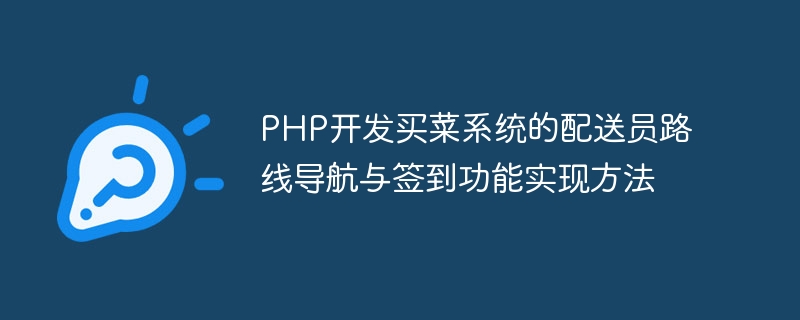

With the development of society and the improvement of people's living standards, more and more people are beginning to use online shopping services to meet their daily needs. Among them, the grocery shopping system, as a convenient service method, is favored by more and more consumers. In order to improve the efficiency and user experience of the grocery shopping system, the delivery driver route navigation and check-in functions are introduced. This article will introduce how to implement these two functions from three aspects: system demand analysis, technology selection, and function implementation.
1. System requirements analysis
Before starting development, we must first conduct a requirements analysis on the system to clarify the functions and characteristics of the system. The main function of the grocery shopping system is to allow users to place orders online, and then have the delivery staff deliver the dishes to the users. Therefore, the system needs to implement the following functions: menu browsing, ordering, payment, delivery staff assignment and route navigation, delivery staff check-in, etc.
2. Technology selection
For the development of the grocery shopping system, we chose PHP as the development language because of its simplicity, ease of learning, and high development efficiency. At the same time, in order to implement route navigation and check-in functions for delivery personnel, we also need to use map navigation and positioning related technologies. Here we choose to use Baidu Map API to implement these two functions.
3. Function implementation
(1) Obtain the latitude and longitude information of the user and delivery person:
When the user places an order, the user's longitude and latitude information can be obtained through the user's address information or map positioning. For delivery personnel, it is necessary to use mobile phone positioning and other methods to obtain their current longitude and latitude information.
(2) Use Baidu Map API for route planning:
Use the route planning service provided by Baidu Map API, use the longitude and latitude information of the user and delivery person as parameters, and send a request to obtain the optimal route information. You can use Baidu Map's JavaScript API or HTTP interface to call the route planning service.
(3) Display the delivery person's route:
Display the obtained optimal route information to the delivery person on the map. You can use Baidu Map's JavaScript API to implement map display and route drawing functions.
(1) Obtain the delivery person Longitude and latitude information:
Before the delivery person signs in, he needs to obtain his current longitude and latitude information. It can be obtained using mobile phone positioning and other methods.
(2) Use Baidu Map API for positioning:
Use the positioning service provided by Baidu Map API, use the longitude and latitude information of the delivery person as parameters, and send a request to obtain the specific location information of the delivery person.
(3) Display the delivery person's location:
Display the obtained delivery person's location information to the administrator on the map. You can use Baidu Map's JavaScript API to implement map display and annotation functions.
Through the implementation of the above two functions, the grocery shopping system can realize route navigation and check-in functions for delivery personnel, thereby improving delivery efficiency and user experience.
Summary:
With the popularity of online shopping, the demand for grocery shopping systems is also increasing. In order to improve the efficiency and user experience of the system, the delivery staff route navigation and check-in functions are introduced. By choosing appropriate technologies and APIs, we can achieve both functions. The above is an implementation method, I hope it will be helpful to everyone.
The above is the detailed content of How to implement the route navigation and check-in functions of the delivery person in the grocery shopping system developed with PHP. For more information, please follow other related articles on the PHP Chinese website!
 Which mobile phone models does Hongmeng OS 3.0 support?
Which mobile phone models does Hongmeng OS 3.0 support?
 A memory that can exchange information directly with the CPU is a
A memory that can exchange information directly with the CPU is a
 Dual graphics card notebook
Dual graphics card notebook
 The role of index.html
The role of index.html
 webstorm adjust font size
webstorm adjust font size
 webservice calling method
webservice calling method
 Introduction to carriage return and line feed characters in java
Introduction to carriage return and line feed characters in java
 Learn C# from scratch
Learn C# from scratch
 How to apply for registration of email address
How to apply for registration of email address




